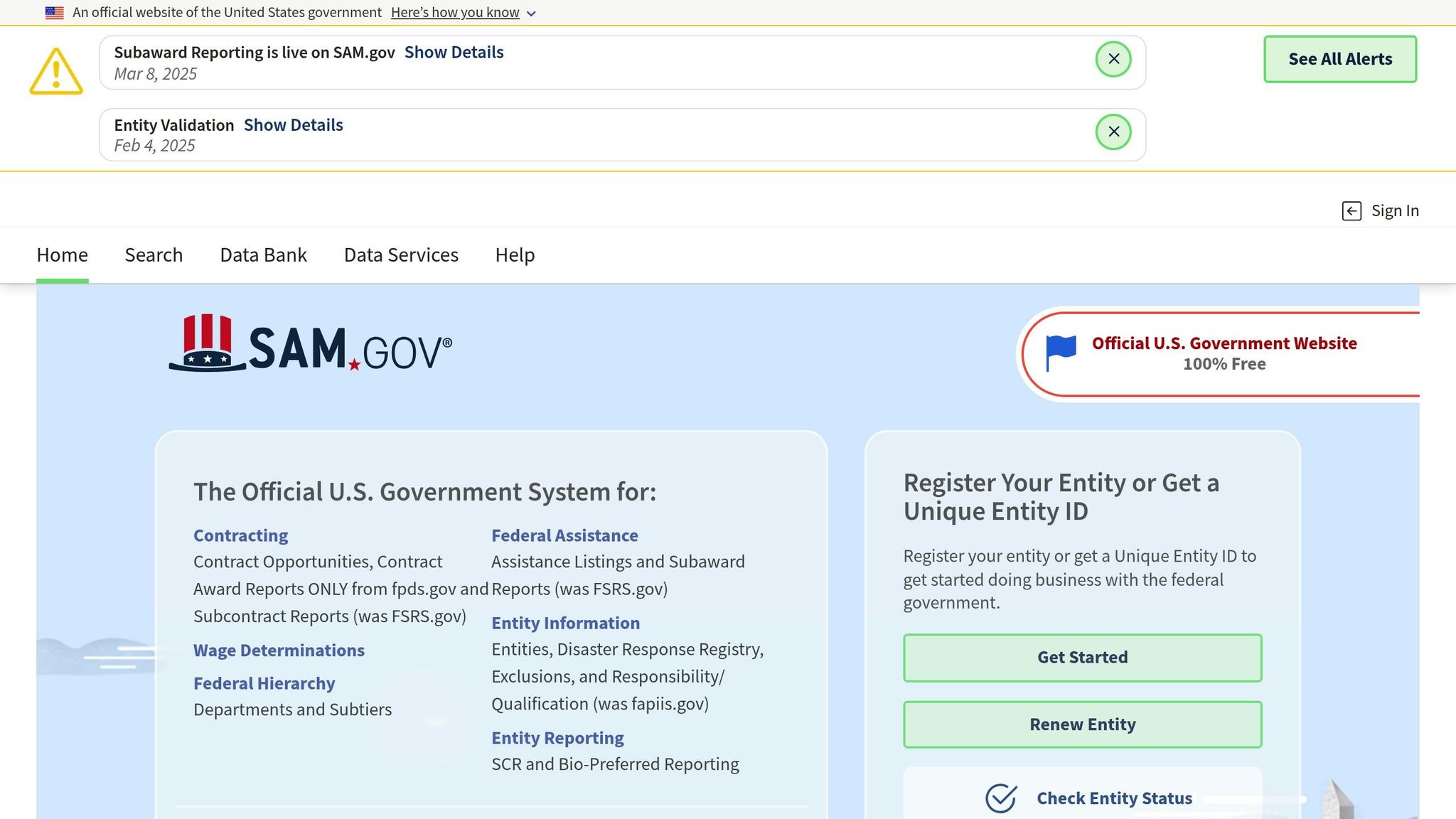Want federal contracts or grants for your business? You’ll need a CAGE Code. This 5-character identifier validates your business for government procurement. Here’s what you need to know upfront:
- Why It Matters: Federal agencies use your CAGE Code to verify your business identity, location, and eligibility for contracts.
- Required Steps: Ensure your SAM.gov profile is active, gather key documents (business name, address, TIN, banking info), and meet federal compliance standards like FAR and DFARS.
- How to Find It: Use SAM.gov or tools like the DLA CAGE Search Tool. For international businesses, check the NCAGE portal.
- Common Issues: Address mismatches, ID errors, and outdated records can block your lookup. Fix these promptly to avoid delays.
Quick Tip: Keep your CAGE Code current by updating your SAM.gov registration annually and monitoring changes in your business details. Missing updates can mean losing contract opportunities.
Want more details? Keep reading for a step-by-step guide to streamline your CAGE Code process.
AVOID THIS! SAM and CAGE Code Registration Mistakes You’re Making
Before You Start
Before diving into your CAGE Code lookup, make sure all your business documents and registrations are in order. Being prepared can help you sidestep common issues that might delay your federal contracting opportunities.
Check SAM.gov Status

Here’s how to check your status on SAM.gov:
- Log into SAM.gov: Use your credentials to access your business profile.
- Review Your Profile: Ensure your profile shows an "Active" status and that your UEI (Unique Entity Identifier) and TIN (Taxpayer Identification Number) are accurate.
Required Documents
You’ll need to have the following documents ready:
| Document Type | Required Information | Purpose |
|---|---|---|
| Business Identity | Legal name, DBA names | Verification |
| Physical Location | Street address, City, State, ZIP | Facility confirmation |
| Tax Documents | EIN/TIN, Tax returns | Business validation |
| Banking Information | Account details, routing numbers | Payment setup |
| Ownership Details | Owner information, citizenship status | Entity validation |
Meet Federal Requirements
The federal government has strict standards for contractors. According to recent GSA data, only 4% of small businesses are on GSA Schedules. To ensure your business is eligible, follow these steps:
- Understand FAR Standards: Familiarize yourself with the Federal Acquisition Regulation (FAR) requirements. These rules govern federal contracts.
- Check DFARS Compliance: If you’re working with the Department of Defense, ensure you meet the Defense Federal Acquisition Regulation Supplement (DFARS) standards.
- Confirm Your Size Standards: Verify that your business qualifies as a small business under the relevant size standards.
With 44% of government awards receiving only one bid, keeping your records accurate and meeting all federal requirements can significantly improve your chances of landing contracts. The U.S. government’s GSA Schedule program is a major channel for federal spending, reaching $45 billion in 2023.
Once you’ve ensured compliance, you’ll be ready to move on to the CAGE Code Search Steps for a smoother process.
CAGE Code Search Steps
SAM.gov Search Method
Here’s how you can find your CAGE Code using SAM.gov:
- Log in to SAM.gov and select the "Search" option.
- Enter your details: Provide your exact legal business name, physical address, UEI, and TIN/EIN.
- Find your CAGE Code: Look for the five-character code in the Entity Information section.
For the best results, keep these tips in mind while searching.
Search Tips
| Search Method | Best Practice | Avoid |
|---|---|---|
| Business Name | Use exact spelling | Abbreviations or alternate names |
| Location | Include ZIP+4 code | Incomplete address information |
| Identifiers | Start with UEI search | Relying solely on DUNS number |
| Filters | Apply "Active" status filter | Including expired registrations |
If SAM.gov doesn’t provide all the information you need, try the alternative methods below.
Other Search Options
If SAM.gov isn’t yielding the desired results, there are additional tools you can use to verify or locate your CAGE Code:
- DLA CAGE Search Tool: The Defense Logistics Agency offers a specialized search portal that provides detailed entity and facility information. This tool is especially helpful for defense contractors.
- FPDS Verification: The Federal Procurement Data System allows you to cross-check your CAGE Code with contract data, ensuring you have the correct identifier for your business.
- NCAGE Portal: For international businesses needing NATO compatibility, the NCAGE portal is a valuable resource. It works within the CAGE framework while addressing international requirements.
To keep a record, take a screenshot of your search results, noting the date, time, platform used, and any relevant identifiers.
sbb-itb-8737801
Fix Common Problems
Here’s how to tackle some frequent issues with CAGE code lookups and ensure smooth processing on SAM.gov:
Fix Address Problems
Address discrepancies can often disrupt CAGE code lookups. Here’s how to resolve them effectively:
| Problem | Solution |
|---|---|
| Format Mismatch | Ensure your address matches USPS standards exactly, like "St." instead of "Street." |
| System Discrepancy | Update your address in SAM.gov first, then sync it with DLA records. |
| Physical Location | Always use a street address – P.O. boxes are not accepted. |
Take care of these address issues first before moving on to other validation errors.
Fix ID Number Issues
Problems with Tax ID numbers or UEI (Unique Entity Identifier) can also block successful lookups. Here’s what to do:
- TIN/EIN Verification: Double-check your Taxpayer Identification Number (TIN) or Employer Identification Number (EIN) against IRS records. If you’ve recently obtained a new TIN/EIN, allow 2-4 weeks for it to fully integrate into the system.
- UEI Synchronization: Make sure your UEI is properly linked to your business profile. Once updated, wait 24-48 hours for the changes to sync across systems.
Fix Validation Errors
Validation errors can be tricky, but sticking to this checklist can help:
- Submit documentation that’s clear, accurate, and less than 90 days old.
- Ensure your legal business name matches exactly with IRS records.
- Align your NAICS codes with your primary business activities.
- Keep your ownership structure consistent across all records.
- If ownership changes occur, update your SAM.gov registration within 30 days.
If you encounter a "No Results Found" message, double-check that your business name is entered exactly as it appears in your tax records.
Finally, keep your CAGE code up to date by regularly monitoring system updates and any changes in your business details.
Keep Your CAGE Code Current
Check Other Systems
To stay on top of federal contracting requirements, ensure your CAGE code information is up-to-date across all relevant government systems. Here’s a quick reference for what to check and how often:
| System | What to Check | Update Frequency |
|---|---|---|
| SAM.gov | Primary registration details | Annually |
| DSBS | Small business status & capabilities | Quarterly |
| GSA eLibrary | Contract information (if applicable) | When contract changes |
| DLA CAGE Website | Core CAGE data | Quarterly |
| FPDS | Contract performance records | After each award |
Yearly Updates
In addition to periodic checks, it’s critical to renew your SAM.gov registration annually to keep your CAGE code active. A compliance calendar can help you stay on track. Here’s how to manage your updates effectively:
- Set Automated Reminders: Schedule alerts at 90, 60, and 30 days before your registration expires. This helps avoid disruptions like delayed payments or ineligibility for new awards.
- Review and Update Key Details:
- Business name and physical address
- TIN/EIN verification
- Banking details for electronic payments
- NAICS codes and size standards
- Points of contact
- Representations and certifications
Business Changes
Any changes to your business require immediate updates to maintain compliance. Use the table below to understand timelines and actions for common changes:
| Business Change | Timeline | Action Required |
|---|---|---|
| Address Change | Immediately | Likely requires a new CAGE code |
| Ownership Change | 7–10 business days | Update ownership details on SAM.gov |
| Legal Name Change | 5–7 business days | Submit legal documentation |
| Business Type Change | 10–14 business days | Update structure and tax information |
| Banking Changes | 3–5 business days | Verify EFT information |
Failing to update your CAGE code can lead to serious issues, including:
- Ineligibility for contracts
- Payment delays
- Rejected proposals
- Compliance violations
Make sure to have all necessary validation documents ready, especially for address updates, to avoid unnecessary delays.
Summary
This section highlights the key steps and common mistakes to help you manage your CAGE code efficiently.
Essential Components for Effective CAGE Code Management
| Component | Key Actions | Update Frequency |
|---|---|---|
| Documentation | Keep your business registration, TIN/EIN, and address up to date | Update as changes occur |
| System Integration | Monitor connections with SAM.gov and other federal systems | Regularly (e.g., quarterly) |
| Compliance | Review certifications, representations, and size standards | Annually |
| Change Management | Update details like physical location, ownership, and banking information | Within days to two weeks of changes |
Key Practices for Success
- Ensure all business documentation is current and easy to access.
- Maintain accurate physical address details.
- Use automated reminders to track renewal deadlines.
- Act quickly to make updates, preventing contract interruptions.
Common Mistakes to Avoid
- Letting your SAM.gov registration expire.
- Missing deadlines for required updates.
- Overlooking the integration of federal systems.
- Skipping annual renewals.
Accurate and well-managed CAGE codes are essential for staying compliant and competitive in federal contracting. Keeping your information up to date helps you avoid payment delays, proposal rejections, and other compliance issues that could harm your business.
For a smoother process, consider using GSA Focus to handle your CAGE code registration and maintenance. By staying proactive with these steps, your business will remain positioned for success in the federal marketplace.
FAQs
What happens if I don’t update my CAGE Code information, and how can I prevent issues?
Failing to keep your CAGE Code information current can create major headaches for your business. You could experience delays in receiving federal contract payments, lose your eligibility for government contracts, or even be removed from government databases entirely. These disruptions can throw a wrench in your operations and shut you out of valuable federal contracting opportunities.
To steer clear of these problems, make it a habit to review and update your CAGE Code details regularly on SAM.gov. Double-check that your business address, contact information, and other essential details are accurate and up to date. Taking these simple steps ensures compliance and keeps your business ready to seize federal opportunities.
What steps do international businesses need to follow to obtain a CAGE Code, and what challenges might arise during the process?
International businesses aiming to obtain a CAGE Code must follow a structured process. The first step is registering in the System for Award Management (SAM), a requirement for doing business with the U.S. federal government. Before completing this registration, international entities also need to secure an NCAGE Code through their country’s designated authority.
However, this process isn’t always straightforward. Businesses may face hurdles like differing documentation requirements, navigating U.S. government compliance standards, or ensuring precise translations of legal and business documents. Another common issue is delays in acquiring the NCAGE Code, which can slow down the entire process. Careful planning and attention to detail can help smooth out these challenges and keep things on track.
What should I do if I encounter validation errors or address mismatches during my CAGE Code lookup?
If you encounter validation errors or issues with address discrepancies during a CAGE Code lookup, the first step is to double-check the details you’ve entered. Make sure your business name, address, and other information align perfectly with what’s listed in your official records, such as your SAM (System for Award Management) registration.
If problems persist, it’s a good idea to contact the Defense Logistics Agency (DLA) for support. Since they handle CAGE Code assignments, they can assist in resolving any mismatches. Additionally, if your business details have changed recently, you may need to update your SAM profile to reflect the latest information. Keeping your records consistent and up-to-date is essential for avoiding unnecessary delays.
Related posts
- Regulatory Requirements for Federal Contracts
- Key Terms in GSA Contracts Explained
- Why Government Entity Codes Matter for GSA Contracts
- GSA Advantage Website 101: A Small Business Guide


